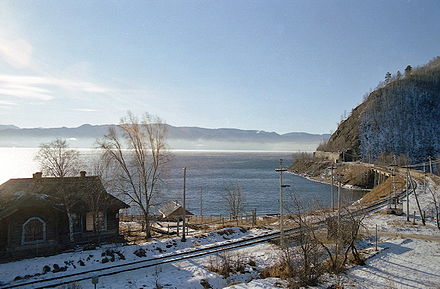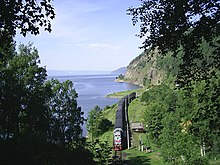Circum–Baikal railway
Circum–Baikal railway was one of these, being the section from Irkutsk to Mysovaya wharf (now the town of Babushkin on the South-Eastern shore of Lake Baikal.Initially, the surveyors proposed to build a pontoon bridge and have the railway go down the right (east) bank of the Angara River (the left bank was too built up); however, later this variant was found to be inexpedient, as the level of water in the Angara was subject to fluctuations, and during spring thaws, crossing the river would have been difficult.With the purpose of establishing a through railway connection, before the Circum-Baikal was finished, it was decided to link the shores of the lake with a train ferry.Despite the difficult terrain along the shoreline, which consisted of a rocky ridge with abrupt slopes, towering 270 to 400 m above the shore, calculations showed this option to be the most economical.The complex terrain of the rocky shore compelled the builders to lay the majority of the route in tunnels or on artificial platforms cut out of the rock; the sides of the railway were strengthened with retaining walls.The workers, already suffering under the hot summers and harsh winters, were required to carry out the majority of the construction by manual labour.The group in charge of development came to an unexpected conclusion and, citing the enormous cost, proposed not to carry out any work on the railway alongside Lake Baikal.From 1947 to 1949 an electric transfer railway from Irkutsk via Bolshoy Lug to Slyudyanka was built, noticeably shortening the distance compared with the Circum–Baikal branch line.The railway lost its strategic importance, the number of trains on the road dropped sharply, and security was withdrawn from the tunnels and bridges.Even at the time of surveying, engineers noted a strong weathering of the rock layers and a large amount of scree.Nevertheless, in spite of the work to prevent natural hazards, landslides were a frequent and dangerous phenomenon on the Circum-Baikal, often leading to crashes and interruptions in traffic.In 1939 on the Western Siberian Railway the Travelling Machine Station was built, which was carried out by anti-landslide workers (including even rock-climbers).On July 29, 1934, a mudflow on this river had catastrophic consequences, carrying off in its wake several apartment houses and covering the station with a thick layer of silt and sand.The tunnels and stone galleries of the Circum–Baikal are unique in that they were constructed atypically and have not been reconstructed since, conserving the initial plan of architects and engineers of the beginning of the century.The inhabitants of the trackside settlements call the train a передача, or "transfer", reflecting the value of this transport for the supply of necessary articles such as bread, salt, matches, vodka, and tobacco.In addition, tourist trains periodically pass along the Cicum-Baikal, including steam locomotives and retro-style cars.Beginning in the early 1980s the tourist potential of the Circum–Baikal Railway began to come into its own (the stations, however, were used to a limited degree since the railroad's inception as an area for dachas and recreation).Along with actual railway sights, tourists on the Circum–Baikal route are attracted by the numerous nature reserves, including the rocky formations such as "Белая выемка".
Circum–Baikal Railway






RussianrailwayIrkutsk regionRussiaLake BaikalSlyudyankaBaikal settlementTrans–Siberian RailwayIrkutskMysovayaBabushkinpontoon bridgeAngara RiverPort BaikalSretensktrain ferryice breakerKultukIvan Vasilʹevich MushketovIrkut RiverBaikalTankhoytunnelsretaining wallviaductssazhensRusso-Japanese Warverstsreinforced concreterevolutionary events of 1917civil warCzechoslovak LegionsSecond World WarelectricIrkutsk Hydroelectric Power StationListvyankadiesel locomotivehandcarsdachasmodernistIrkutsk State UniversityLokomotivVoluntary Sports SocietyYuri LevitanskyVladimir TomilovskyWayback Machine